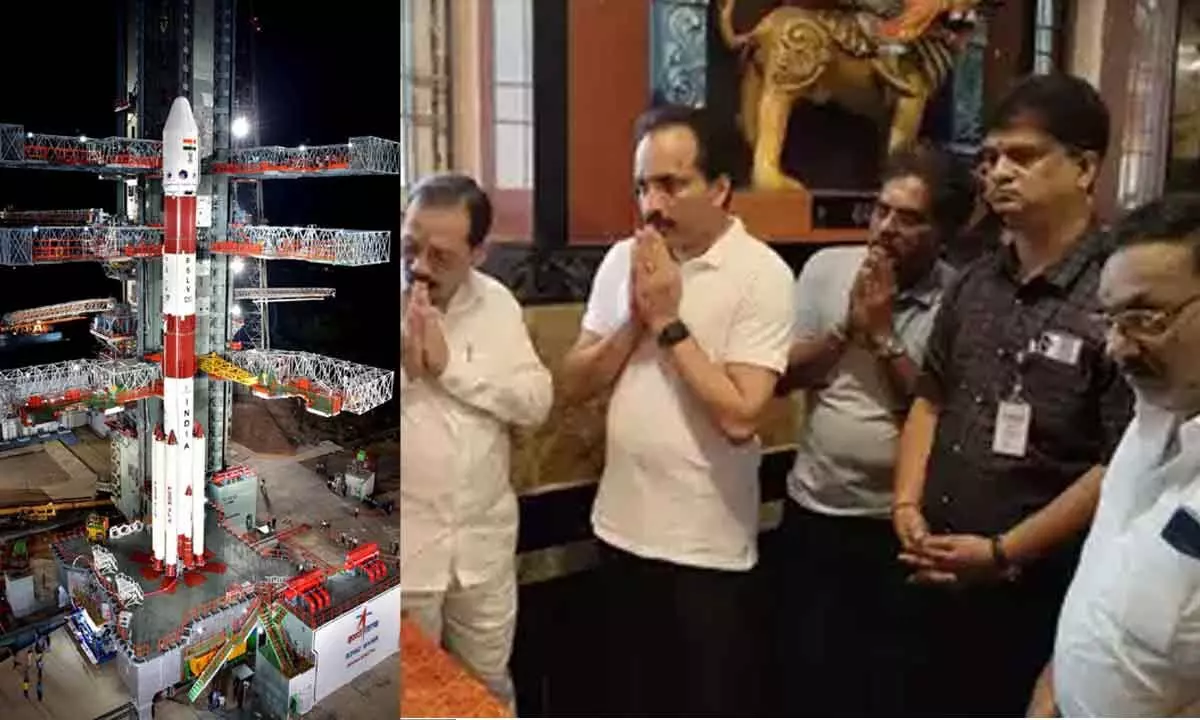Sriharikota: All set for Sun mission

ISRO Chairman S Somanath offering prayers at Chengalamma temple in Sullurpet in Tirupati ahead of the launch of Aditya L1 mission on Friday
125-day Aditya voyage to begin from today with 11.50 am launch
Sriharikota (AP) : Days after landing on the Moon, India will aim for the Sun on Saturday with its maiden solar expedition, as ISRO's trusted PSLV will carry the Aditya L1 mission on a 125-day voyage to the Sun. The 23.10 hour countdown for the launch of Aditya L1 onboard PSLV C57 commenced here on Friday, ISRO said.
The Sun observatory mission will be fired from the second launch pad at this spaceport at 11.50 am on Saturday, and comes close on the heels of India's successful moon expedition last month, Chandrayaan-3.
ISRO Chairman S Somanath said the Sun mission will take 125 days to reach the exact radius. Aditya L1 is designed for providing remote observations of the solar corona and conduct in-situ observations of the solar wind at L1 (Sun-Earth Lagrangian point), which is about 1.5 million kilometres from the Earth.
According to ISRO, there are five Lagrangian points between the Sun and the Earth, and the L1 point in the Halo orbit would provide a greater advantage of continuously viewing the Sun without any occurrence of eclipse. "This will provide a greater advantage of observing the solar activities continuously," ISRO said.
On embarking on such a complex mission, the Bengaluru headquartered space agency said the Sun is the nearest star and therefore can be studied in much more detail as compared to the others. By studying the Sun much more about could be learnt about stars in the Milky Way as well as in various other galaxies, ISRO said.
ISRO scientists have used 'XL', the more powerful variant of the polar satellite launch vehicle (PSLV) that would carry the spacecraft on Saturday along with the seven payloads. Similar PSLV-XL variants were used in the Chandrayaan-1 mission in 2008 and the Mars Orbiter Mission (MOM) in 2013. Of the total seven payloads, four onboard the spacecraft would directly view the Sun while the remaining three would undertake in-situ studies of particles and fields at the L1 point. Initially, the Aditya-L1 spacecraft would be placed in a low earth orbit. It would be made more elliptical and later the spacecraft will be launched towards the Lagrange point L1 by using on-board propulsion systems. As the spacecraft travels towards L1, it will exit the Earth's gravitational Sphere of Influence. After exit, the cruise phase will start and subsequently, the spacecraft will be injected into a large halo orbit around L1. It would take nearly four months to reach the intended L1 point.
The Aditya-L1 payloads are expected to provide the most crucial information to understand the problems of coronal heating, Coronal mass ejection (CME), pre-flare, and flare activities, and their characteristics, dynamics, and space weather.

















